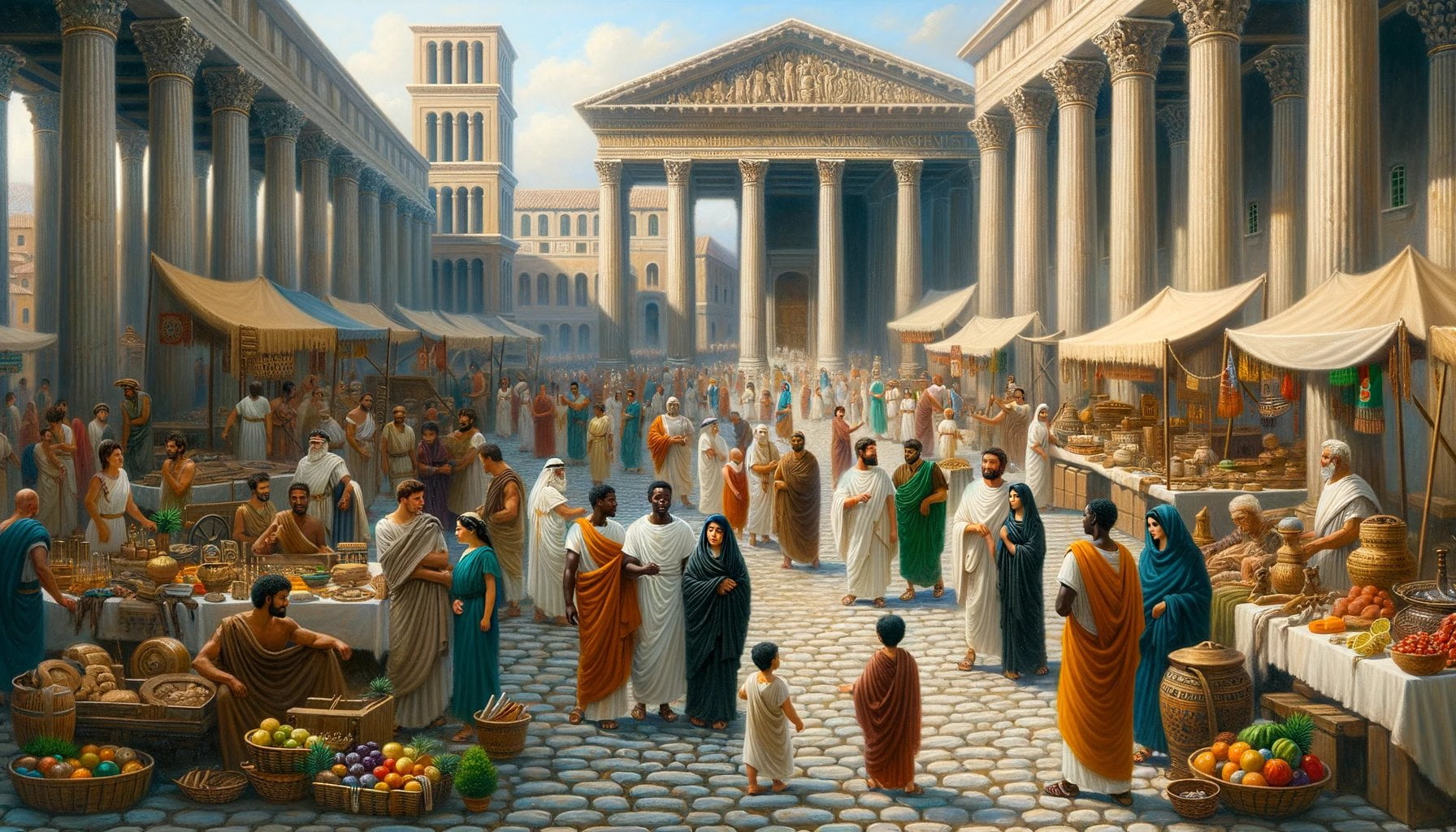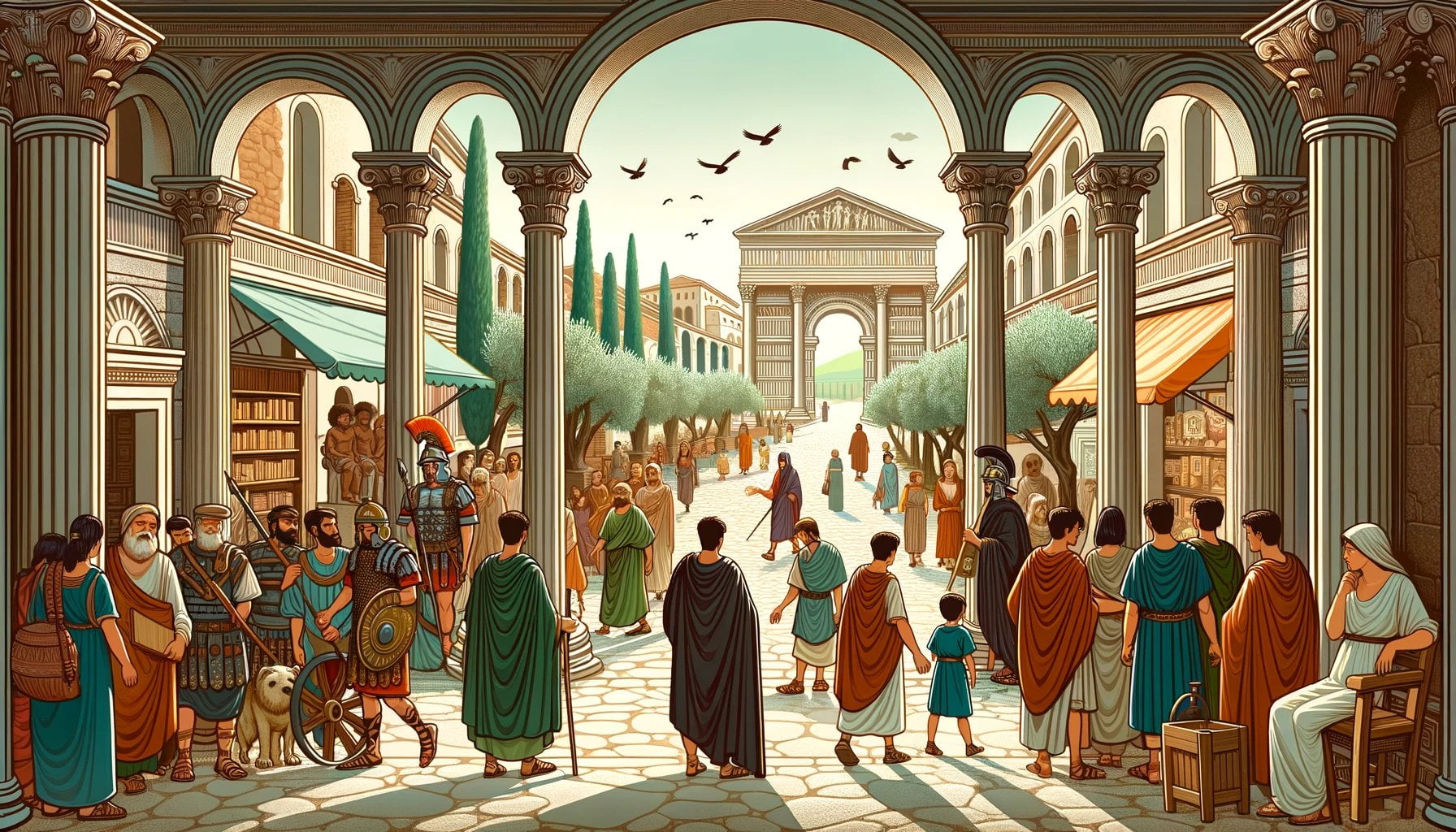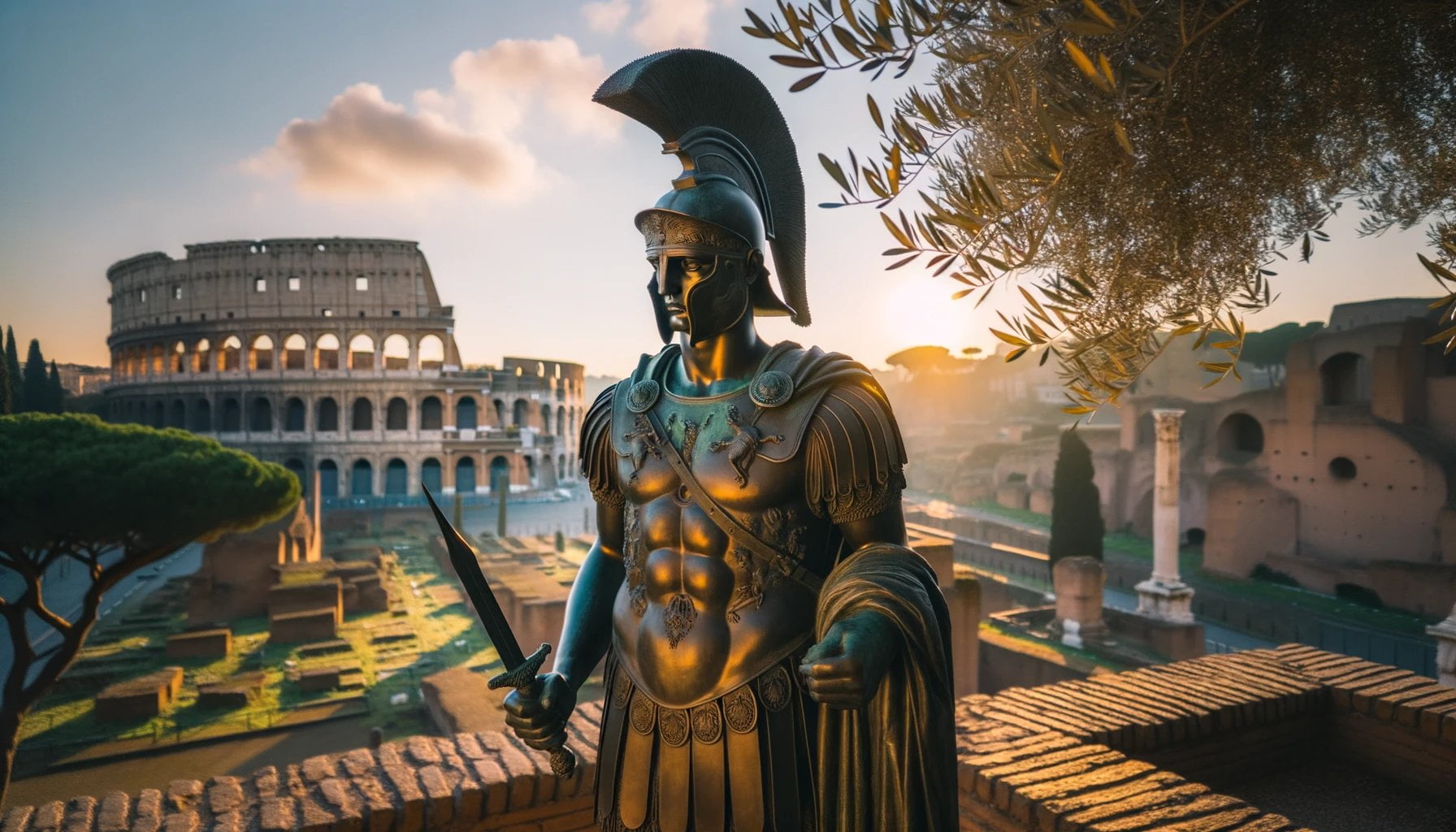Uncovering Ancient Rome’s Black Origins: Challenging Narratives and Embracing Cultural Diversity delves into the fascinating and often overlooked aspect of ancient Rome’s rich history – its black origins. This captivating article aims to challenge traditional narratives and shed light on the significant contributions of African cultures to the foundation and development of the ancient city. By embracing cultural diversity and exploring the interconnectedness of ancient civilizations, we can gain a more comprehensive and inclusive understanding of Rome’s heritage.

Key Takeaways:
- Skin color in ancient Rome was categorized, but it did not carry social implications or determine a person’s social identity.
- Terms such as “afer,” “maurus,” “niger,” and “ater” were commonly used to refer to darker-toned physical characteristics encountered in daily life around the Mediterranean.
- The term “Aethiopes” referred to particularly dark-skinned peoples and had remote and legendary connotations.
- Aethiopia was imagined to be located within the upper part of the torrid zone in the Sahara desert, described as an area surrounded by the Red Sea.
- The presence of Aethiopes in Rome was considered evidence of remarkable and expensive events.
- Depictions of skin color in ancient Rome often showed a distinct contrast between men and women, with men having tanned skin from working outside and women being paler from staying indoors.
- Skin color did not lead to the development of racial hierarchies and racism as it exists today in ancient Rome.
- Ancient Romans did not view black skin as a sign of inferiority or use it as a basis for societal divisions.
Black Origins of Ancient Rome
The history of ancient Rome is often associated with grand architecture, powerful emperors, and sprawling conquests. However, there is a lesser-known aspect of this ancient civilization that deserves attention—the black origins of ancient Rome. In this article, we will delve into the evidence and theories surrounding the presence of black people in ancient Rome, challenging traditional narratives and embracing the cultural diversity that influenced the foundation and development of this remarkable city.
Diversity in Ancient Rome
To understand the black origins of ancient Rome, we need to acknowledge the diversity that existed in this cosmopolitan city. The Romans encountered people of various skin tones, from pale to very dark, as they expanded their empire and interacted with different cultures. Terms such as “afer,” “maurus,” “niger,” and “ater” were commonly used to refer to darker-toned physical characteristics encountered in daily life around the Mediterranean.
Aethiopia: The Legendary Land of Darkness
The earliest reference to black people in ancient Rome can be traced back to the legendary land of Aethiopia. In Homer’s Odyssey, Poseidon visits the Ethiopians, describing them as a distant group divided into two. Aethiopia was envisioned as a land located within the upper part of the torrid zone in the Sahara desert, surrounded by the Red Sea and merging into unknown territories.
While the term Aethiopia held mythical connotations, it also represented dark-skinned peoples. However, it is important to note that ancient writers did not provide detailed scientific categorizations or establish racial hierarchies based on skin color. The exact definition of Aethiopes remains unclear, further highlighting the complexity and fluidity of ancient Roman perceptions of skin color.
Rome’s Encounters with Black People
In ancient Rome, encounters with individuals with dark skin, referred to as Aethiopes, were rare within the capital city. The presence of Aethiopes was often seen as an extraordinary event, signaling remarkable and expensive displays such as gladiatorial shows composed entirely of black participants. Reports even depict an Aethiopian soldier in Britannia during the reign of Emperor Septimius Severus, whose black skin was viewed as an ominous sign.
Artistic representations from ancient Rome also shed light on the diversity of skin tones. Men, who spent considerable time outdoors, were often depicted with deeply tanned skin, while women, who generally stayed indoors, maintained a paler complexion. It is intriguing to note that ancient Roman artwork frequently portrayed individuals with very dark skin and tightly-curled hair.
Ancient Rome’s View on Skin Color
Contrary to modern understandings of racism, ancient Rome did not view black skin as a sign of inferiority or a basis for societal divisions. Skin color did not carry social implications or determine a person’s worth or social identity. In fact, the ancient Greeks and Romans prided themselves on their autochthony, their deep connection to their land, and did not consider skin color as a hindrance to integration in society.
While the color black was associated with ill-omens in ancient Roman religious beliefs, it is essential to recognize that racism, as understood today, did not develop until after the classical period. The Romans had cultural interactions, trade routes, and intellectual exchanges with diverse populations, which influenced their perceptions of skin color and acceptance of different cultures.
Embracing Cultural Diversity
By uncovering the black origins of ancient Rome, we challenge the traditional narratives and shed light on the remarkable cultural diversity that played a significant role in shaping this ancient civilization. It is crucial to recognize and celebrate the contributions of African cultures to the foundation and development of Rome. By embracing cultural diversity, we gain a more comprehensive and inclusive understanding of ancient Rome’s rich heritage.
In conclusion, ancient Rome was a melting pot of cultures, and its encounters with black people, referred to as Aethiopes, left an indelible mark on the city’s history. While skin color was categorically noticed, it did not lead to the development of racial hierarchies or the systemic racism we witness today. The ancient Romans had a more nuanced and fluid understanding of skin color, emphasizing their autochthony and embracing cultural diversity. Let us continue to explore and celebrate the black origins of ancient Rome, challenging the narratives that overlook the contributions of black cultures to our shared history.
Sources:
1. Black people in ancient Roman history
In ancient Rome, there were many important people who played significant roles in shaping the empire. From influential leaders to renowned philosophers, these individuals left a lasting impact on history. To learn more about the important people in ancient Rome, click here.
If you’re fascinated by ancient weaponry, you won’t want to miss the ancient Rome dagger. This formidable weapon was used by Roman soldiers and gladiators alike, and its design and craftsmanship are truly remarkable. Discover more about the ancient Rome dagger by clicking here.
Ancient Rome was known for its mastery of warfare, and their weapons were a testament to that. From the powerful gladius to the mighty catapult, these weapons were vital in conquering and defending the empire. Explore the fascinating world of ancient Rome weapons by clicking here.
The insulae were the ancient Roman equivalent of apartment buildings, housing a large number of people in a limited space. These multi-story structures were a common sight in ancient Rome and served as homes for people from all walks of life. To delve into the intriguing history of insulae in ancient Rome, click here.
Highlighting the Influence of African Cultures on Roman Art, Architecture, and Religious Practices
Throughout history, ancient Rome has captivated our imaginations, with its grand architecture, mesmerizing art, and rich cultural heritage. However, there is a lesser-known aspect of Rome’s history that deserves our attention: the significant influence of African cultures on Roman art, architecture, and religious practices. While this connection has often been overlooked or overshadowed, it is crucial to explore and shed light on the contributions of African cultures to the foundation and development of ancient Rome.
Key Takeaways:
– African cultures had a profound impact on Roman art, architecture, and religious practices, extending from regions in present-day Egypt to Britain.
– Roman architectural styles, such as amphitheaters, public baths, and palaces, were incorporated by Africans into their own structures.
– Art and architecture in Africa during the first millennia CE were heavily influenced by Christian and Muslim traders, conquerors, and settlers.
– Ancient Rome, with its vast empire, left an indelible mark on art and architecture worldwide, including African societies.
– African architecture in sub-Saharan Africa showcases diverse styles, with notable examples like the ruins of Great Zimbabwe.
The intricate and dynamic exchange between African and Roman cultures has shaped the artistic landscape and cultural practices of both societies. To understand the depth and significance of this exchange, we must delve into the historical evidence and theories that connect African cultures to ancient Rome.
African Influences in Roman Art:
Roman art is renowned for its masterful sculptures, captivating frescoes, and intricate mosaics. But what many may not realize is that these artistic achievements were influenced by African cultures. In fact, ancient Roman art frequently portrayed individuals with dark skin and tightly-curled hair, challenging commonly held stereotypes about race and ancient civilizations.
By examining these representations, art historians have uncovered connections between Roman art and African cultures. African artistic traditions, such as sculpture, painting, and pottery, have left their mark on Roman art, enriching its diversity and reflecting the multicultural nature of the empire.
African Contributions to Roman Architecture:
Roman architecture was characterized by grandeur, innovation, and engineering excellence. It is fascinating to discover that African cultures played a role in shaping these architectural wonders. Africans incorporated Roman architectural styles, like amphitheaters, public baths, and palaces, into their own structures. This integration showcases not only the exchange of architectural knowledge but also the blending and adaptation of cultural practices.
Furthermore, the ruins of Great Zimbabwe stand as a testament to the intricate architectural achievements of ancient African societies. With massive defensive walls and conical towers, these ruins exemplify the ingenuity and skill of African architecture.
The Influence of African Religions on Roman Practices:
Religion played a pivotal role in Roman society, and here too, African cultures made significant contributions. With the rise of Christianity and Islam in Africa during the first millennia CE, African religious practices began to influence Roman religious traditions.
African Christian and Muslim traders, conquerors, and settlers brought their distinct religious beliefs and practices to Roman territories, prompting an evolution in Roman religious practices. This intermingling of cultures gave rise to unique syncretic religious traditions, incorporating elements from African religions into Roman practices.
By recognizing and studying these African influences, we gain a more comprehensive and inclusive understanding of ancient Rome’s heritage. It allows us to challenge traditional narratives and appreciate the interconnectedness of ancient civilizations.
In conclusion, the black origins of ancient Rome deserve our attention and exploration. The influence of African cultures on Roman art, architecture, and religious practices is a testament to the richness and diversity of our shared human history. By shedding light on these connections, we move one step closer to a more inclusive and accurate understanding of the ancient world.
Sources:
1. Oxford Academic: Images and Interpretation of Africans in Roman Art and Social
2. Encyclopedia Britannica: African Architecture
Investigating the Role of African Soldiers and Their Contributions to the Roman Empire
Key Takeaways:
– Roman Africans, including individuals from sub-Saharan Africa, played a significant role in shaping the cultural landscape of ancient Rome.
– Africans made contributions to various aspects of Roman society, including the military, religion, and intellectual pursuits.
– Emperor Septimus Severus, a native of Roman Libya, became Rome’s first African emperor, highlighting the influence of African troops in the empire.
– The diversity of the Roman army, which included soldiers from Africa, contributed to the multiculturalism of the Roman Empire.
– Scipio Africanus, one of Rome’s greatest generals, showcased the strategic brilliance of individuals from Africa.
– There is a growing body of research exploring the black origins of ancient Rome, challenging traditional narratives and highlighting the contributions of Africans.
Ancient Rome, often depicted as a white European civilization, had a rich history that encompassed diverse cultures and peoples. In recent years, there has been a growing interest in uncovering the contributions of African soldiers and their roles in the Roman Empire. By investigating the historical evidence and challenging traditional narratives, we can gain a more comprehensive and inclusive understanding of ancient Rome’s black origins.
Skin Tone and Physical Differences
In classical antiquity, Greek and Roman writers were familiar with people of various skin tones, including those with dark skin and tightly-curled hair. These individuals, commonly referred to as Aethiopes or “black,” were occasionally mentioned in surviving writings and depicted in artworks. Their presence in ancient Rome suggests that encounters with people of African descent were not uncommon.
Roman Africans: Soldiers and More
Roman Africans constituted a diverse group, including local Berbers, Punics, descendants of populations from Rome and Roman Italy, as well as individuals from different regions of the Roman Empire. They made significant contributions to various aspects of Roman society.
One notable example is Emperor Septimus Severus, who was born in Roman Libya and became Rome’s first African emperor. He is believed to have mustered troops from Africa and led successful campaigns during his reign. The diversity of the Roman army greatly influenced the diversity of the Romans as a whole, both in Britain and throughout the empire.
Contributions to Christianity
Roman Africans were not only influential in military matters but also in their religious practices. While they initially adopted the Roman pantheon, they were among the first provinces to convert to Christianity. Notable figures, such as Saint Felicita, Saint Perpetua, Saint Cyprian, and Saint Augustine, emerged from this group, contributing to the spread of Christianity within the Roman Empire.
Challenging Narratives and Uncovering Black Origins
Unfortunately, the central role of Africans in the history of Rome has often been overshadowed and hidden through selective narration and manipulation of historical artifacts. However, there is a growing body of research that challenges these traditional narratives and sheds light on the significant influence and contributions of Africans to the development of ancient Rome.
Research suggests that the Roman Empire had interactions with regions of West Africa, such as Ghana, Mali, and Songhai, establishing trade and political connections. These interactions contributed to cultural exchanges between Rome and West Africa, shaping the development of both regions.
Individuals like Scipio Africanus, who played a vital role in the Second Punic War, exemplify the military brilliance and contributions of individuals from Africa. Scipio’s achievements, including the liberation of Massiva, highlighted the strategic capabilities of African soldiers.
Recognizing and investigating the role of African soldiers and their contributions to the Roman Empire allows us to paint a more accurate picture of ancient Rome’s history. By uncovering the black origins of Rome and embracing its cultural diversity, we can challenge conventional narratives, promote inclusivity, and gain a deeper understanding of this fascinating civilization.
Sources:
- Africans Contributions to Rome: Black Romans – AfricaResource
- Black people in ancient Roman history – Wikipedia
Discussing Theories and Controversies Surrounding the Black Origins of Ancient Rome
Ancient Rome, with its rich history and cultural heritage, is often associated with grand architecture, influential leaders, and intricate societal structures. However, there is a lesser-known aspect of ancient Rome that deserves attention: its black origins. By delving into this topic, we can challenge traditional narratives, shed light on the contributions of African cultures, and paint a more comprehensive and inclusive picture of ancient Rome’s heritage.
Understanding the Terms: Aethiopia and Aethiopes
To begin our exploration, it’s important to understand the terms used to describe individuals with darker skin tones in ancient Roman history. The terms “afer,” “maurus,” “niger,” “ater,” “fuscus,” “perustus,” and “melas” were used interchangeably to refer to people with different shades of skin color. Among these terms, “aethiopes” specifically referred to dark-skinned peoples.
The exact definition of “aethiopia” is unclear in ancient texts. However, it represents a legendary land visited by Poseidon in the Odyssey and was commonly imagined to be located somewhere within the upper part of the torrid zone in the Sahara desert, beyond the edge of the known world.
The Presence of Aethiopes in Ancient Rome
In ancient Rome, encounters with individuals referred to as “aethiopes” were rare but noteworthy. Artists frequently depicted these individuals with very dark skin and tightly-curled hair, showcasing their diversity of appearance. The mention of “aethiopes” in surviving writings and the portrayal of dark-skinned individuals in art offer glimpses into the multiculturalism of ancient Rome.
It’s worth mentioning that skin color did not carry social implications or identities in ancient Rome. While the color black was associated with ill-omens in Roman religion, it was not seen as a basis for judging a person’s worth or social status. The Romans, with their ethnocentric mindset, compared themselves to others but did not consider skin color as a determining factor for superiority or inferiority.
The Significance and Controversies
Exploring the black origins of ancient Rome challenges traditional narratives and uncovers the diverse origins of this renowned civilization. By recognizing and emphasizing the contributions of African cultures, we gain a deeper understanding of ancient Rome’s heritage and cultural exchange.
Key Takeaways:
– Ancient Rome encountered people of various skin tones, including individuals referred to as “aethiopes.”
– Skin color in ancient Rome did not carry social implications or identities.
– Artistic representations frequently depicted individuals with very dark skin and tightly-curled hair.
– The exact definition of “aethiopia” is unclear, but it represents a legendary land beyond the known world.
– By recognizing the black origins of ancient Rome, we challenge traditional narratives and embrace cultural diversity.
Sources:

FAQ
Q1: What is the significance of black people in ancient Roman history?
A1: Black people, referred to as Aethiopes, had a presence in ancient Rome and made cultural contributions to Roman society. It challenges traditional narratives and highlights the diverse origins of ancient Rome.
Q2: How were black people perceived in ancient Rome?
A2: Skin color in ancient Rome did not carry social implications or determine a person’s social identity. Greeks and Romans did not view black skin as a sign of inferiority, and it was not a basis for judging a person’s worth or societal divisions.
Q3: Were there black Roman emperors?
A3: Yes, there were black Roman emperors. Emperor Septimus Severus, born in Roman Libya, became Rome’s first African emperor. Caracalla, also known as Kara-kalla, was a black Roman emperor as well.
Q4: What contributions did Africans make to ancient Rome?
A4: Africans/Aethiopes made significant cultural contributions to Roman society. They played key roles in various fields, including the military, Christianity, art, and music, shaping the diverse and vibrant history of Rome.
Q5: How did black people influence the Roman Empire beyond Rome?
A5: The Roman Empire had a significant influence on Africa and established trade and political connections in regions such as Ghana, Mali, and Songhai. These interactions contributed to a cultural exchange between Rome and West Africa.
json
{
"@context": "https://schema.org",
"@type": "FAQPage",
"mainEntity": [
{
"@type": "Question",
"name": "What is the significance of black people in ancient Roman history?",
"acceptedAnswer": {
"@type": "Answer",
"text": "Black people, referred to as Aethiopes, had a presence in ancient Rome and made cultural contributions to Roman society. It challenges traditional narratives and highlights the diverse origins of ancient Rome."
}
},
{
"@type": "Question",
"name": "How were black people perceived in ancient Rome?",
"acceptedAnswer": {
"@type": "Answer",
"text": "Skin color in ancient Rome did not carry social implications or determine a person's social identity. Greeks and Romans did not view black skin as a sign of inferiority, and it was not a basis for judging a person's worth or societal divisions."
}
},
{
"@type": "Question",
"name": "Were there black Roman emperors?",
"acceptedAnswer": {
"@type": "Answer",
"text": "Yes, there were black Roman emperors. Emperor Septimus Severus, born in Roman Libya, became Rome's first African emperor. Caracalla, also known as Kara-kalla, was a black Roman emperor as well."
}
},
{
"@type": "Question",
"name": "What contributions did Africans make to ancient Rome?",
"acceptedAnswer": {
"@type": "Answer",
"text": "Africans/Aethiopes made significant cultural contributions to Roman society. They played key roles in various fields, including the military, Christianity, art, and music, shaping the diverse and vibrant history of Rome."
}
},
{
"@type": "Question",
"name": "How did black people influence the Roman Empire beyond Rome?",
"acceptedAnswer": {
"@type": "Answer",
"text": "The Roman Empire had a significant influence on Africa and established trade and political connections in regions such as Ghana, Mali, and Songhai. These interactions contributed to a cultural exchange between Rome and West Africa."
}
}
]
}
- Unveiling the Enigma: Mansoureh Khojasteh Bagherzadeh’s Public Appearances & Private Life in Iran - July 18, 2025
- Unveiling the Mystery: Mansoureh Khojasteh Bagherzadeh’s Husband: A Rare Glimpse into a Private Life - July 18, 2025
- Unveiling Masoud Khamenei’s Mother: Power, Influence, and Iran’s Future - July 18, 2025
















